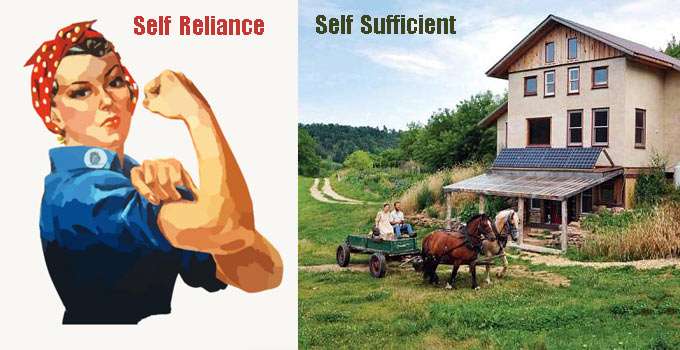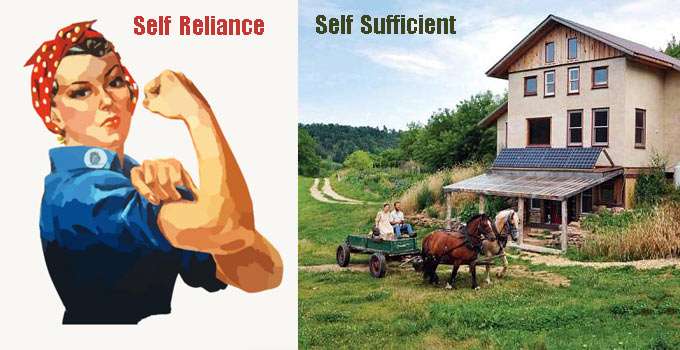In this article, we will explore the distinction between self-sufficient and self-sustaining living. We will discuss the concept of off-grid living and delve into the differences between these two terms. By the end, you will have a clear understanding of what it means to be self-sufficient and self-sustaining, and you’ll be able to apply this knowledge to your own lifestyle choices.

Exploring the Distinction: Self-Sufficient vs. Self-Sustaining Living
Living a self-sufficient or self-sustaining lifestyle has become increasingly popular in recent years. As people strive for greater independence and sustainability, these two approaches to living off the grid have gained significant attention. While both concepts aim to reduce reliance on external resources, there are distinct differences between self-sufficiency and self-sustainability. In this article, we will delve into these two models of living, exploring their key principles, benefits, challenges, and case studies. By the end, you will have a better understanding of these lifestyles and the steps you can take to transition towards a more sustainable and autonomous way of living.
Defining Self-Sufficient Living
Self-sufficient living refers to a lifestyle in which individuals or communities aim to meet all their needs without relying on external resources. This includes producing their own food, generating energy, and managing waste. By taking control of their essential needs, self-sufficient individuals strive for greater independence and autonomy. Whether through establishing off-grid communities or practicing homesteading, self-sufficient living is all about relying on oneself and minimizing dependence on outside systems.
Key Principles of Self-Sufficiency
There are several key principles that guide self-sufficient living:
- Food Production: Self-sufficient individuals prioritize growing their own food through methods like permaculture and organic farming. They aim to create a sustainable food system that meets their nutritional needs.
- Energy Generation: Embracing renewable energy sources, self-sufficient individuals seek to generate their own energy through solar, wind, or hydro power. This reduces their reliance on fossil fuels and traditional energy providers.
- Water Management: Self-sufficiency entails efficient water management, including rainwater harvesting, proper filtration, and wastewater treatment. This ensures a constant supply of clean water for various purposes.
- Waste Management: Self-sufficient living promotes minimal waste generation and efficient waste management systems, such as composting, recycling, and reusing materials.
Exploring Self-Sustaining Living
While self-sustaining living may appear similar to self-sufficiency, it has its own distinct characteristics. Self-sustaining living involves a more holistic approach to sustainability, focusing on long-term resource security and resilience in the face of external factors. It goes beyond just meeting immediate needs and extends to preserving resources for future generations.
Key Principles of Self-Sustainability
Self-sustaining living is guided by the following principles:
- Resource Conservation: Self-sustainable individuals prioritize the conservation of resources by reducing consumption, reusing materials, and recycling waste. This minimizes their ecological footprint and promotes a more sustainable lifestyle.
- Renewable Energy Systems: Embracing renewable energy sources is crucial for self-sustainability. By harnessing solar, wind, or geothermal energy, individuals can achieve a self-sustaining energy system that is environmentally friendly and economically viable.
- Resilience and Adaptability: Self-sustaining living emphasizes resilience in the face of external factors, such as climate change or economic instability. This includes preparing for potential challenges and adapting to changing circumstances.
- Collaboration and Community Building: Self-sustainability is often achieved through collaborative efforts and community-building. By sharing resources, knowledge, and skills, individuals can create a more sustainable and supportive environment.
Comparison between Self-Sufficiency and Self-Sustainability
While self-sufficiency and self-sustainability share similar goals of reducing reliance on external resources, they differ in their approaches to resource management, flexibility, and adaptability.
Different Approaches to Resource Management
Self-sufficiency focuses on producing everything needed within a closed system, relying on individual or community efforts. It aims to become self-reliant, producing food, energy, and other essential resources locally. On the other hand, self-sustainability recognizes the importance of collaboration and utilizes external resources when necessary. It prioritizes long-term resource conservation and aims to create a more sustainable future.
Flexibility and Adaptability in Self-Sufficient and Self-Sustaining Lifestyles
Self-sufficiency requires a high level of self-reliance and may be more rigid in terms of adapting to external factors. On the contrary, self-sustainability encourages flexibility and adaptability. Individuals who embrace self-sustainability have the freedom to explore and utilize various resources and technologies to achieve their goals while being mindful of their long-term impact.
Benefits of Self-Sufficient Living
Living a self-sufficient lifestyle offers numerous benefits, both on an individual and environmental level.
Increased Independence and Autonomy
Self-sufficiency provides individuals with a sense of independence and autonomy. By meeting their own needs, they have control over their resources, reducing dependency on outside systems. This increased self-reliance fosters a sense of empowerment and resilience.
Reduced Environmental Impact
Self-sufficient living minimizes environmental impact by reducing reliance on fossil fuels, promoting sustainable farming practices, and adopting renewable energy sources. By producing their own food and energy, self-sufficient individuals contribute to a more sustainable and eco-friendly lifestyle.
Benefits of Self-Sustaining Living
Self-sustainability offers distinct advantages that contribute to long-term resource security and resilience.
Long-term Resource Security
By conserving resources and embracing renewable energy, self-sustaining individuals ensure a constant supply of essential resources. This long-term resource security provides stability and reduces vulnerability to external factors such as fluctuating markets or climate change.
Resilience in the Face of External Factors
Self-sustaining living prepares individuals for potential challenges by fostering adaptability and resilience. By diversifying resources and building self-reliant systems, they can withstand external disruptions and maintain a sustainable lifestyle.
Challenges of Self-Sufficient Living
While self-sufficient living has its benefits, it also presents unique challenges that individuals must navigate.
Initial Investment and Start-up Costs
Transitioning to self-sufficiency often requires a significant upfront investment. Setting up systems for food production, energy generation, and water management can be costly. However, these costs are often outweighed by the long-term benefits and savings.
Managing Food Production and Sustainability
Growing enough food to sustain oneself or a community can be challenging. It requires knowledge of farming techniques, soil management, and the ability to adapt to changing weather conditions. Managing food production sustainably while avoiding depletion of resources requires ongoing effort and learning.
Challenges of Self-Sustaining Living
Self-sustaining living also presents its own set of challenges that individuals must overcome.
Continuous Maintenance and Monitoring
Maintaining self-sustaining systems, such as renewable energy infrastructure or water management systems, requires constant monitoring and upkeep. It may require regular maintenance, repairs, and periodic upgrades to ensure optimal performance.
Balancing Resource Consumption and Preservation
Achieving a balance between resource consumption and preservation is a constant challenge in self-sustaining living. Individuals must carefully manage their resource usage while ensuring that enough is preserved for future needs.
Case Studies of Self-Sufficient Living
Examining real-life examples can provide valuable insights into the practical implementation of self-sufficient living.
Off-Grid Communities
Off-grid communities, such as The Farm in Tennessee, showcase the collective efforts of individuals striving for self-sufficiency. These communities have established their own food production systems, renewable energy sources, and waste management solutions, demonstrating the feasibility and sustainability of self-sufficient living.
Permaculture and Homesteading Examples
Permaculture systems, such as Polyface Farm in Virginia, incorporate regenerative farming practices that mimic natural ecosystems. These systems promote self-sufficiency by integrating livestock, crops, and natural cycles, resulting in a productive and sustainable food production model.
Case Studies of Self-Sustaining Living
Exploring self-sustaining living through case studies sheds light on the diverse approaches individuals and communities take to achieve long-term sustainability.
Eco-Villages and Sustainable Development Projects
Eco-villages, like Findhorn in Scotland, prioritize sustainable practices and community living. These projects embrace renewable energy, ecological building materials, and organic gardening, creating an integrated and self-sustaining living environment.
Renewable Energy Systems and Infrastructure
Renewable energy infrastructure projects, like the Masdar City in Abu Dhabi, exemplify large-scale self-sustaining projects. These developments harness solar and wind power, incorporate energy-efficient technologies, and prioritize sustainable transportation, showcasing the potential for self-sustaining urban living.
Tips for Transitioning to Self-Sufficiency
Transitioning towards self-sufficiency requires careful planning and consideration of personal needs and goals.
Assessing Personal Needs and Goals
Understanding what drives your desire for self-sufficiency is essential. Assess your needs, priorities, and long-term goals to develop a tailored plan that aligns with your vision for a self-sufficient lifestyle.
Developing Skills and Knowledge
Building the necessary skills and knowledge is fundamental for a successful transition to self-sufficiency. Learn about organic farming, renewable energy, water management, and other relevant topics to ensure a smooth and informed transition.
Tips for Transitioning to Self-Sustainability
Transitioning towards self-sustainability involves a comprehensive resource management plan and exploration of alternative energy sources.
Creating a Comprehensive Resource Management Plan
Develop a resource management plan that encompasses energy, food, water, and waste. This includes evaluating your current consumption patterns, setting realistic goals, and identifying sustainable alternatives to reduce your ecological footprint.
Exploring Alternative Energy Sources
Embrace renewable energy sources, such as solar or wind power, to reduce reliance on fossil fuels. Research different technologies, assess their feasibility for your specific situation, and explore incentives and grants that may be available to support your transition.
Considerations for a Balanced Approach
While self-sufficiency and self-sustainability have distinct characteristics, integrating both approaches can lead to a more balanced and resilient lifestyle.
Integrating Self-Sufficiency and Self-Sustainability
Combining elements of self-sufficiency and self-sustainability can create a well-rounded approach to sustainable living. By harnessing self-sufficiency’s focus on individual or community resilience and self-reliance, while also embracing self-sustainability’s emphasis on long-term resource conservation and collaboration, individuals can create a more holistic and impactful lifestyle.
Building Community and Collaborative Efforts
Community-building is crucial for a balanced approach to sustainable living. By engaging with like-minded individuals, sharing resources and knowledge, and collaborating on projects, individuals can create a support network that enhances their self-sufficient and self-sustaining efforts.
Conclusion
In conclusion, both self-sufficient and self-sustaining living offer unique opportunities for individuals and communities to reduce their reliance on external resources and embrace a more sustainable and autonomous lifestyle. While self-sufficiency focuses on meeting immediate needs within a closed system, self-sustainability takes a broader view, prioritizing long-term resource security and resilience. By understanding the key principles, benefits, and challenges of these two approaches, individuals can make informed decisions and take the necessary steps towards achieving a more sustainable and autonomous way of life. Continued adaptation and collaboration will be crucial in navigating future challenges and creating a more sustainable future for all. So why not embark on your journey towards self-sufficient or self-sustaining living today?




